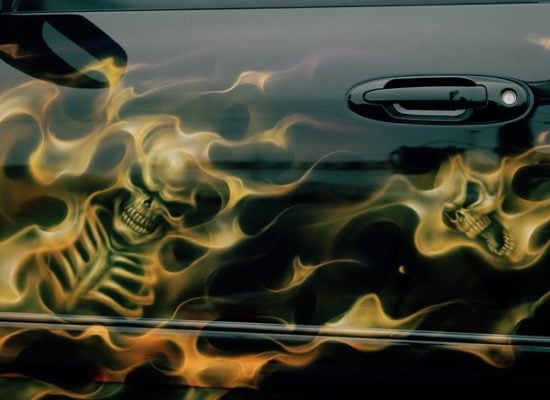Ambrose Bierce, that drawing room curmudgeon, coined what is perhaps the greatest definition of optimism. He said it was “the doctrine or belief that everything is beautiful, including what is ugly.” That idea, severely expressed, fits Justine Kurland’s new exhibition of garage and urban desert photographs at Mitchell-Innes & Nash to a grimy Valvoline tee.
Titled “Sincere Auto Care” with demotic aplomb (the new series of work is named after an actual auto body shop in Nebraska), Kurland’s exhibition functions, according to the gallery press release, as an exploration of American car culture and the enduring fantasy of the open road. But, in our time, the once robust cruiser-ideal of Ford and GM has given way to massive layoffs and killer ignition switches, while the epic adventure of Easy Rider has downshifted to survival of the fittest in The Rover. In theaters and on the street, Manifest Destiny has shed its rosy-cheeked utopianism for a grizzled dystopian pallor. No wonder its exhausted face shows up repeatedly in Kurland’s photos looking feral, meth-addicted, and unemployed.
Yet the thing about idealists—and Kurland is one in spades—is that they are able to see a three-course meal in a head of cabbage, or Old Master compositions in a snapshot of Rusty, the Mechanic. A photographer of staged naked idylls and lush landscapes full of actual hippie communards, Kurland often lets her romantic side get the best of her. For this we should be grateful. A serious purveyor of postindustrial photography—in the form of later series that feature classically down-and-out themes—the artist has more recently taught herself to combine Whitmanesque drift with Garry Winogrand grit. Her present-day pictures are of the rust-belt imagist variety. In them, Kurland’s optimism goes mostly shirtless, sports lots of axle grease, and wears loud tattoos.
Images of stripped cars, cracked block engines, busted windshields and the sort of characters that loiter at dead-end auto repair shops, Kurland’s photos meditate not so much on dystopianism per se, as on the disappearing possibilities of the great American dream. Its fading power is displayed directly in photographs that feature twisted metal, dirty white bodies and crushed blue-collar ideals. A collection of 36 modest-sized color prints—the artist has hung them according to her own personal sense of emotional and formal echoes—the show presents cars, auto body frames, scrap metal parts, and human beings as requiring heavy repair. This is the state of the Obama union according to Kurland. When Walker Evans pictured the Great Depression, he found similar inspiration in the broken bodies and faces of the Burroughs, Fields, and Tingle families.
Despite the collision-repair theme, the majority of Kurland’s photographs are so well ordered that they deliberately invoke classical paintings. Carefully composed landscapes and still-lifes, they feature mostly grungy, unpeopled views of oil-slick exurbia and used-tire-type tableaux—but captured at perfect angles. One such photo, Framed Headlight, presents the lamp of a broken down Chevy as seen through the window of a freestanding car door. Another, titled Watermelon Still Life, features a pair of incidental crosses, a few insolent struts peeking behind a “New and Used Tires” sign (these recall the backwards cross in Giotto’s Legend of Saint Francis, Institution of the Crib at Greccio in Assisi), and a crescent-shaped piece of watermelon on a towel. The melon suggests the swaddled baby Jesus. The garage may not look at all like the nativity scene at the local mall next to the Quiznos, but neither did Joseph’s filthy manger.
Of the few photographs that feature actual people, several stand out as displaying painterly light. One titled What Casper Might Look Like if he Grew Up to be a Junkie in Tacoma—the name reference is to Kurland’s 10-year-old son, whose portrait is located a few frames away—presents a sallow-skinned young man looking into the sun as his hands wrap prayerfully around a Coke can. Another, called Baby Tooth, zeroes in on a dirty hand holding a lit molar. But a third, pegged simply 280 Coup, embraces Caravaggesque painterly effects with tenebrist abandon. Not just a photo of an inked dude under the chassis of a stripped down Mercedes, the image directly references Michelangelo Merisi’s The Conversion on the Way to Damascus. Here, Kurland’s transformation of the auto-care mundane is complete: This car is not a car but St. Paul’s spooked horse; the grease-monkey beneath the Merc is no mere mechanic, but a saint struck dumb in a spasm of roughneck ecstasy.
Kurland’s optimism is so well wrought, it’s contagious. Her dramatically lit and hopeful photos make it almost possible to believe there is glimmer of transcendence in America’s shabbiest, most threadbare stories.
Justine Kurland, “Sincere Auto Care” is at Mitchell-Innes & Nash, 534 West 26th Street, New York, through October 11, 2014.
